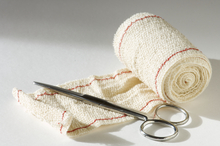
A horse barn's basic medicine cabinet
Keeping basic medical supplies on-hand will keep you prepared to cope with many common problems.
If you own a horse, you certainly understand that they are beautiful and fragile animals. Over a period of ownership, you will be called upon to doctor and care for various wounds and sicknesses under your veterinarian's care and instruction. Keeping a properly stocked medicine cabinet will help you care for your animals quickly and cost effectively.
Below are some suggestions that will help you stock your medicine cabinet with the basics that you will need when treating your animals.
Medicines
Many drugs and medications are available both over the counter and through a pharmacy. We suggest you ask your veterinarian for a suggested list of medications, considering expiration dates and your horse's particular needs and usage. Your veterinarian may suggest one or more of the following:
- Bute (prescription NSAID)
- Banamine (prescription NSAID)
- Anthelmintics (wormers) based on your parasite control program
- Vaccinations based on your infectious disease control program
- Omeprazole (Ulcer preventative treatment for stressed horses)
- Others depending on your horses
In most cases, these can be purchased directly from your veterinarian.
Salves and ointments
Salves and ointments are applied to the skin and in some cases, directly to wounds. Follow the directions of your veterinarian and the product instructions prior to application.
- Lanolin based cream
- Nitrofurazone
- ichthammol
- Sterile eye wash
Medical tools
These are the basics. Having the tools available to you is not enough. Learn how to use the tools and practice using them. When your horse is sick or hurt is not the time to learn.
- Digital thermometer
- Stethoscope
- Bandage scissors
- Normal scissors
- Forceps or Tweezers
- Rubber gloves
Bandages and wraps
Applying dressings to wounds and bandaging legs are the most common healthcare activities of the horse owner. Like everything else, you should be instructed in the proper use of bandages and wraps for effective and safe use.
- Standing wraps (reusable and washable)
- Sheet cotton
- Quilted leg wraps (reusable and washable)
- Duct tape
- Adhesive medical tape
- Vet wrap (ask your vet how to use - may cause damage or pain)
- Elasticon (expensive but works great)
- Sterile gauze 4"x4"
- Rolled gauze bandage 4" width
Hoof care
This list of equipment should be on-hand for routine hoof care and the occasional pulled-shoe sort of issues. Please note that any puncture wound to the hoof is an emergency. Call your veterinarian or farrier immediately for advice.
- Duct tape
- Small stiff brush
- Small hammer
- Pliers
- Thrush treatment medicine
- Hoof pick
- File
Wound preparation
Cleaning and preparing a wound for bandaging requires products that can be applied to the damaged area without causing pain, while effectively cleansing the wound.
- Betadine (povidone-iodine) solution for cleaning minor wounds
- Betadine scrub for surgical preparation and hand cleaning - do not apply to wounds!
Dig deeperTM
If you enjoyed this article, and like to be prepared for common equine care issues, we recommend that you explore our First Aid Health Center
